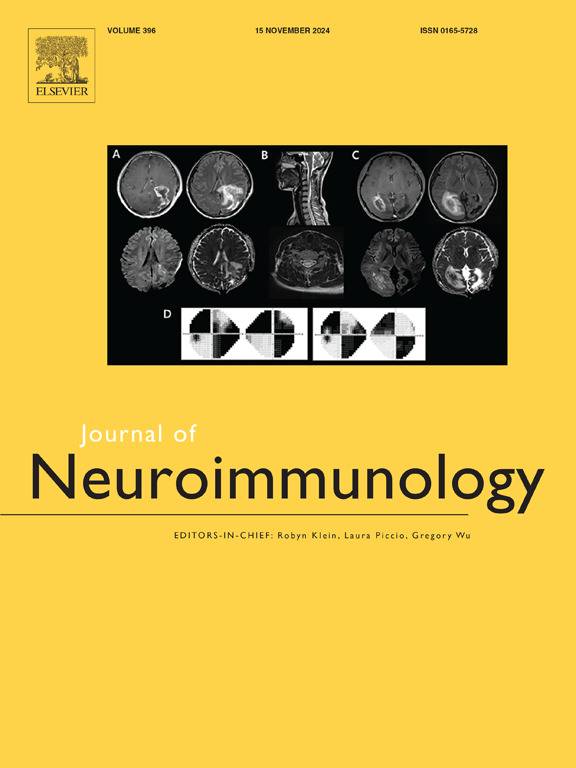Exploring the role of altered oxi-inflammasome activity in the immunobiology of inflammatory neuropathies
IF 2.5
4区 医学
Q3 IMMUNOLOGY
引用次数: 0
Abstract
Objectives
Inflammasome plays a significant role in inflammatory responses. The role of inflammasome and its interactions with oxidative stress markers has not been examined in inflammatory neuropathies like Guillain-Barré syndrome (GBS) and chronic inflammatory demyelinating polyradiculoneuropathy (CIDP). This study aims to explore the roles of inflammasome and oxidative stress pathways in inflammatory neuropathies.
Methods
This case-controlled study comprised patients with inflammatory neuropathies (n = 60, GBS = 44, CIDP = 16) and age- and gender-matched healthy controls (n = 60). The expressions of inflammasome-related genes (Nlrp3, Casp1, and Il1b) were quantified along with the plasma levels of malondialdehyde (MDA), the end product of lipid peroxidation in all study participants.
Results
The expressions of Nlrp3 (p = 0.0083) and Casp1 (p = 0.0007) genes were significantly up-regulated in GBS patients compared to controls. The plasma MDA levels were also markedly higher in GBS patients than in controls (p = 0.029). The gene expression levels of Nlrp3, Casp1, and Il1b and plasma MDA levels were comparable between CIDP patients and healthy controls. There were no correlations between the expressions of the studied genes and MDA levels with the clinical scores of GBS.
Conclusion
The up-regulated expression of Nlrp3 and Casp1 genes and increased levels of MDA suggest the presence of an activated oxi-inflammatory pathway in GBS. These findings provide a new dimension to the current understanding of the immuno-pathogenesis of GBS.
探讨炎性神经病变免疫生物学中氧化炎性小体活性改变的作用
目的炎性小体在炎症反应中起重要作用。炎性小体的作用及其与氧化应激标志物的相互作用在炎性神经病如格林-巴勒综合征(GBS)和慢性炎性脱髓鞘性多根神经病变(CIDP)中尚未得到研究。本研究旨在探讨炎性小体和氧化应激途径在炎性神经病变中的作用。方法本病例对照研究包括炎性神经病变患者(n = 60, GBS = 44, CIDP = 16)和年龄和性别匹配的健康对照组(n = 60)。在所有研究参与者中,对炎症小体相关基因(Nlrp3、Casp1和Il1b)的表达以及丙二醛(MDA)的血浆水平进行了量化,丙二醛是脂质过氧化的最终产物。结果与对照组相比,GBS患者Nlrp3 (p = 0.0083)和Casp1 (p = 0.0007)基因表达明显上调。GBS患者血浆MDA水平也明显高于对照组(p = 0.029)。在CIDP患者和健康对照组中,Nlrp3、Casp1和Il1b的基因表达水平和血浆MDA水平具有可比性。研究基因表达及MDA水平与GBS临床评分无相关性。结论Nlrp3和Casp1基因表达上调,MDA水平升高,提示GBS中存在激活的氧化-炎症通路。这些发现为目前对GBS免疫发病机制的理解提供了一个新的维度。
本文章由计算机程序翻译,如有差异,请以英文原文为准。
求助全文
约1分钟内获得全文
求助全文
来源期刊

Journal of neuroimmunology
医学-免疫学
CiteScore
6.10
自引率
3.00%
发文量
154
审稿时长
37 days
期刊介绍:
The Journal of Neuroimmunology affords a forum for the publication of works applying immunologic methodology to the furtherance of the neurological sciences. Studies on all branches of the neurosciences, particularly fundamental and applied neurobiology, neurology, neuropathology, neurochemistry, neurovirology, neuroendocrinology, neuromuscular research, neuropharmacology and psychology, which involve either immunologic methodology (e.g. immunocytochemistry) or fundamental immunology (e.g. antibody and lymphocyte assays), are considered for publication.
 求助内容:
求助内容: 应助结果提醒方式:
应助结果提醒方式:


